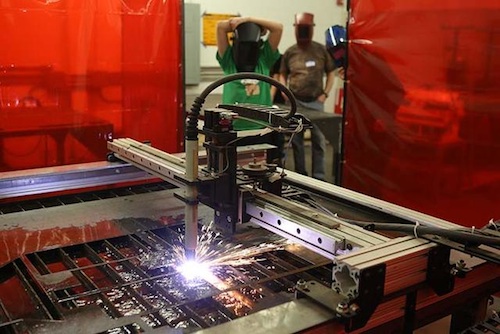Battling Robots Help MathWorks Get Aspiring Engineers in its Corner
April 11, 2014
An epic battle. Access to one of the country’s largest makerspaces and the latest in design tools and fabrication technologies. A mere two weeks to build and design an autonomous robot that will take down the competition.
No, this is not a Discovery Channel TV competition, but rather a local, in-person event sponsored by MathWorks, Autodesk, Artisan’s Asylum, and SparkFun Electronics. The Autonomous Robot Design Challenge, set to kick off this week in Somerville, MA, is the latest in MathWorks’ on-going efforts to court up-and-coming engineers with a variety of in-school and out-of-school learning initiatives.
In its second year, the Autonomous Robot Design Challenge invites students, engineers, and would-be makers to take part in a two-week contest in which they are charged with conceiving and constructing an autonomous robot from the tools and technologies provided on-site at the competition.
The event is held at the Artisan’s Asylum, a non-profit, 40,000 sq. ft. community workspace that provides members with access to tools they wouldn’t necessarily be able to afford on their own. Engineers, artists, and entrepreneurs can get their hands on technologies such as 3D printers, CNC machines, a full computer lab, welding bays, wood shops, and 3D design tools, including Autodesk’s Fusion 360 CAD software and MathWorks’ MATLAB and Simulink technical computing software.
Unlike other robotics competitions where teams have a long lead time and do prior work on their entries, this event tasks challengers to build the robots with only the tools that are available in the Artisan Asylum makerspace during its hours of operation over the course of two weeks.
“With most technical competitions or engineering challenges, students take a semester or two to prepare for the competition,” explains Paul Kassebaum, who handles maker community relations at MathWorks, and who is one of the orchestrators of the competition. “This is in sharp contrast—people will walk in off the street with nothing and in two weeks, they’ll design an autonomous robot without having any institutional knowledge built up.”
Participants will be furnished with basic hardware like motors and sensors, and there will be tutorials offered to cover the basics of using Autodesk Fusion 360 or MATLAB as part of the robot design.
The partnership with the maker community is instrumental in proving how shallow the learning curve has become for using critical design and engineering technologies, says Kassebaum. In addition, the maker movement also exposes MathWorks software to a broader segment of the market, he says.
The Autonomous Robot Design Challenge is just one of 27 competitions MathWorks is hosting this year, according to Tom Gaudette, the company’s principal academic evangelist. These events are important, Gaudette says, because they are an example of project-based learning. “We see the maker spaces as an example of really great hands-on project-based learning where students come in, get trained on the tools, and are learning through that exercise,” he explains. “Through that process, they learn more than they would in traditional classroom learning.”
In addition to sponsoring out-of-classroom events like the Autonomous Robot Design Challenge, MathWorks also sponsors in-classroom training, working with professors to help integrate the MathWorks software into the curriculum. “We want to enable students to get comfortable using industry-standard tools to solve problems repeatedly in different classes,” he says. In that way, they can concentrate on learning the topic of the class rather than focusing on learning the tools, he explains.
The Autonomous Robot Design Challenge kicks off tomorrow. The grand finale and robot battle will be held on April 27 and will be open to the public.
Check out this video to get a glimpse of last year’s robot take down.
Subscribe to our FREE magazine, FREE email newsletters or both!
About the Author
Beth Stackpole is a contributing editor to Digital Engineering. Send e-mail about this article to [email protected].
Follow DE







